Excerpts from Jim Conrad's
Naturalist Newsletter
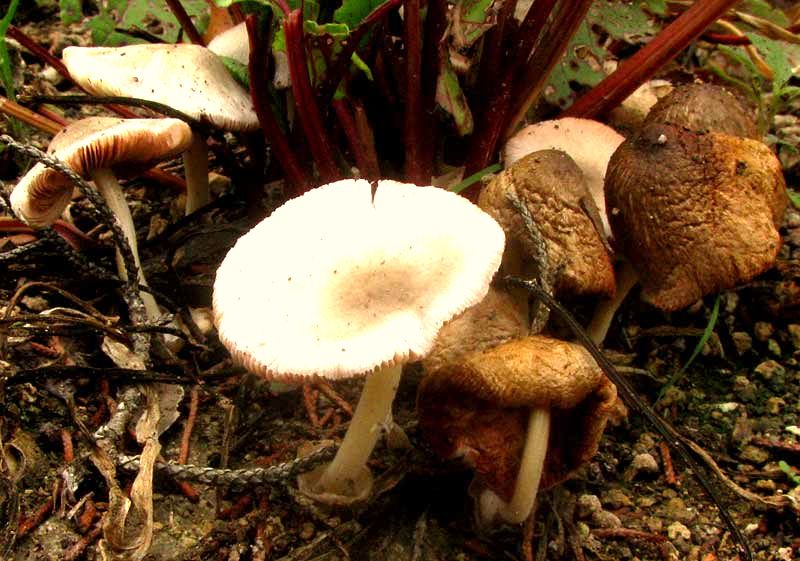
from the July 6, 2014 Newsletter issued from the Frio Canyon Nature Education Center in the valley of the Dry Frio River in northern Uvalde County, southwestern Texas, on the southern border of the Edwards Plateau; elevation ~1750m (~5750 ft); N29.62°, W99.86°; USA
VOLVARIELLA MUSHROOM
In the same raised bed in which last week's Cone Cap Mushrooms turned up, also for several days after a good dousing rain a cluster arose of the ones shown above. The cluster formed around a tuft of dark red beet leaves, the stems of which are seen in the background, providing scale for the picture, and indicating that these are smallish mushrooms, the cap up front only about two inches across (5cm).
At first glance this looks like an exceptionally nondescript mushroom, one that would be hard or impossible to identify. However, if you study the picture you see that one very important field mark gives us hope: Each mushrooms' stem arises from a little cup-like structure known as the volva. In the world of mushrooms, only a small percentage of species produce such well formed volvas. A closer look at a volva is shown below
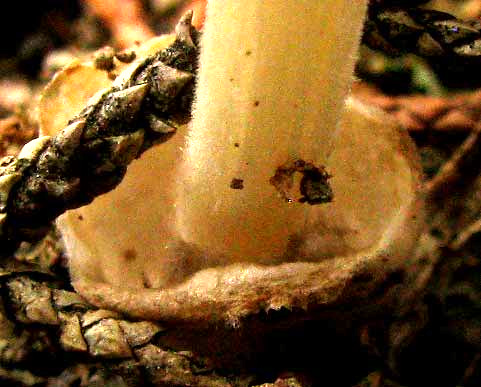
Notice that this volva is whitish inside but dark and quite hairy outside, and even the mushroom's lower stem is hairy. Another important feature to check when gathering information for later identification is the manner in which gills beneath the cap attach to the stem. Attachment can range from "not at all," to slightly, to broadly attached, to actually having the gills descend well down the stem. This mushroom's attachment was "not at all," forming a definite "notch" between the stem and gills. Such gills are said to be "free," and once again this is a feature of only a minority of mushroom species, so now that we're looking closely we're seeing that our plain-looking mushroom does have its idiosyncrasies. Below, you can see our mushroom's free gills and the notch between the gills and stem:
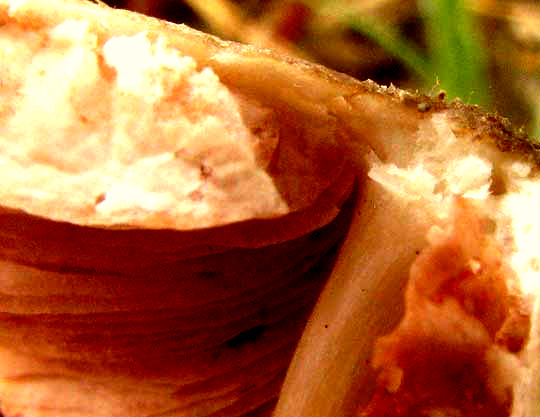
One of the most important of all field marks when identifying mushrooms is that of spore color. I collected several gilled wedges of caps in different stages of development for making a spore print that would show the color, but none produced enough spores for a good print. The most immature wedge did produce a few -- enough to indicate that the spores were not white -- as seen below:
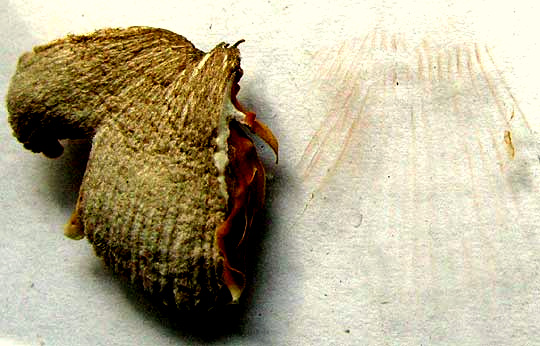
In that picture, radiating lines of spores are barely visible on the right side, each line corresponding to a gill releasing spores beneath the cap wedge at the left.
Despite such an inconclusive outcome, it's clear that the spores aren't white, and that really surprised me. That's because when I see mushrooms arising from such well formed volvas, the first two mushroom types to come to mind are the Amanitas, which include some of the most beautiful and deadly of all mushroom species, and the commonly occurring genus Lepiota. And both of those mushroom types produce white spores. I'd guessed that our mushroom was either an Amanita or a Lepiota, but the non-white spores prove that it's something else.
By now we'd registered such excellent field marks -- the volva, the free gills, the non-white spores -- that in the end it was relatively easy to peg our mushrooms as members of the genus Volvariella, which Michael Kuo at MushroomExpert.Com describes as an easily recognized genus because they "... have pink gills and spore prints and, as the genus name suggests, volvas at the stem base."
Pink spores... Ours don't look particularly pink to me but they could be.
It's hard to say which of several species we have. A species found in this general area is VOLVARIELLA BOMBYCINA, and our mushroom looks close enough to that. That species' caps are conspicuously hairy, while are hairy but not conspicuously; their advanced age may explain that.
Our mushrooms' caps are definitely hairy, as shown below: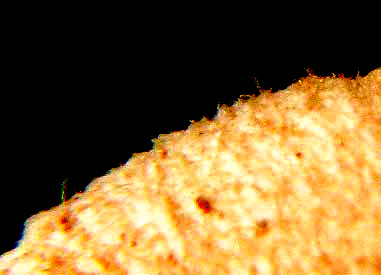
Volvariella bombycina occurs practically worldwide, though mostly in Europe, North America and Mexico. It's "saprobic," meaning that it lives on decaying organic matter, such as the layer of old cow manure beneath my raised bed's soil.